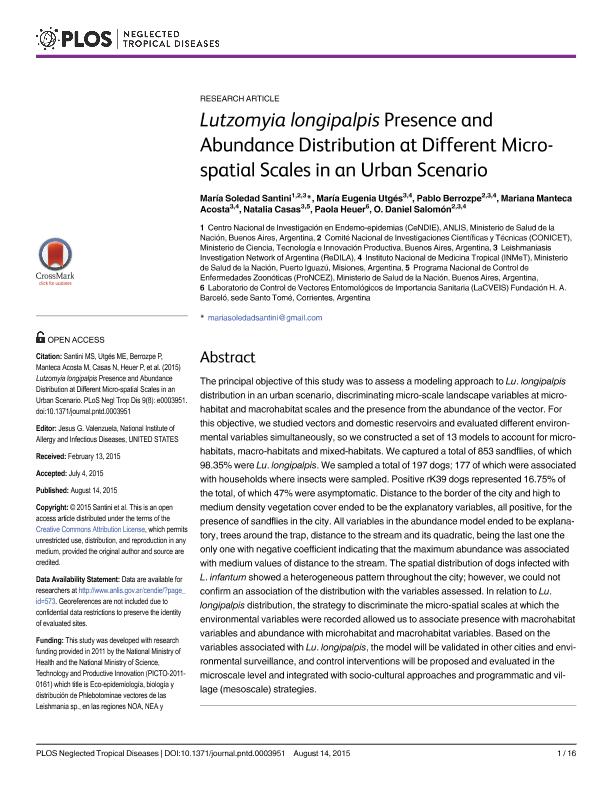Mostrar el registro sencillo del ítem
dc.contributor.author
Santini, Maria Soledad

dc.contributor.author
Utgés, María Eugenia

dc.contributor.author
Berrozpe, Pablo Eduardo

dc.contributor.author
Manteca Acosta, Mariana

dc.contributor.author
Casas, Natalia
dc.contributor.author
Heuer, Paola
dc.contributor.author
Salomón, Oscar Daniel

dc.date.available
2018-03-01T18:54:01Z
dc.date.issued
2015-08-14
dc.identifier.citation
Santini, Maria Soledad; Utgés, María Eugenia; Berrozpe, Pablo Eduardo; Manteca Acosta, Mariana; Casas, Natalia; et al.; Lutzomyia longipalpis presence and abundance distribution at different microspatial scales in an urban scenario; Public Library of Science; PLoS Neglected Tropical Diseases; 9; 8; 14-8-2015; 1-16
dc.identifier.issn
1935-2727
dc.identifier.uri
http://hdl.handle.net/11336/37569
dc.description.abstract
The principal objective of this study was to assess a modeling approach to Lu. longipalpis distribution in an urban scenario, discriminating micro-scale landscape variables at microhabitat and macrohabitat scales and the presence from the abundance of the vector. For this objective, we studied vectors and domestic reservoirs and evaluated different environmental variables simultaneously, so we constructed a set of 13 models to account for microhabitats, macro-habitats and mixed-habitats. We captured a total of 853 sandflies, of which 98.35% were Lu. longipalpis.We sampled a total of 197 dogs; 177 of which were associated with households where insects were sampled. Positive rK39 dogs represented 16.75% of the total, of which 47% were asymptomatic. Distance to the border of the city and high to medium density vegetation cover ended to be the explanatory variables, all positive, for the presence of sandflies in the city. All variables in the abundance model ended to be explanatory, trees around the trap, distance to the stream and its quadratic, being the last one the only one with negative coefficient indicating that the maximum abundance was associated with medium values of distance to the stream. The spatial distribution of dogs infected with L. infantum showed a heterogeneous pattern throughout the city; however, we could not confirm an association of the distribution with the variables assessed. In relation to Lu. longipalpis distribution, the strategy to discriminate the micro-spatial scales at which the environmental variables were recorded allowed us to associate presence with macrohabitat variables and abundance with microhabitat and macrohabitat variables. Based on the variables associated with Lu. longipalpis, the model will be validated in other cities and environmental surveillance, and control interventions will be proposed and evaluated in the microscale level and integrated with socio-cultural approaches and programmatic and village (mesoscale) strategies.
dc.format
application/pdf
dc.language.iso
eng
dc.publisher
Public Library of Science

dc.rights
info:eu-repo/semantics/openAccess
dc.rights.uri
https://creativecommons.org/licenses/by-nc-sa/2.5/ar/
dc.subject
Lutzomyia Longipalpis
dc.subject
Leishmaniasis Visceral
dc.subject.classification
Otras Ciencias Biológicas

dc.subject.classification
Ciencias Biológicas

dc.subject.classification
CIENCIAS NATURALES Y EXACTAS

dc.title
Lutzomyia longipalpis presence and abundance distribution at different microspatial scales in an urban scenario
dc.type
info:eu-repo/semantics/article
dc.type
info:ar-repo/semantics/artículo
dc.type
info:eu-repo/semantics/publishedVersion
dc.date.updated
2018-03-01T13:52:41Z
dc.identifier.eissn
1935-2735
dc.journal.volume
9
dc.journal.number
8
dc.journal.pagination
1-16
dc.journal.pais
Estados Unidos

dc.journal.ciudad
San Francisco
dc.description.fil
Fil: Santini, Maria Soledad. Dirección Nacional de Institutos de Investigación. Administración Nacional de Laboratorios e Institutos de Salud. Centro Nacional de Diagnóstico e Investigaciones Endemo-epidémicas; Argentina. Consejo Nacional de Investigaciones Científicas y Técnicas; Argentina. Red de Investigación de la Leishmaniasis en Argentina; Argentina
dc.description.fil
Fil: Utgés, María Eugenia. Red de Investigación de la Leishmaniasis en Argentina; Argentina. Ministerio de Salud. Instituto Nacional de Medicina Tropical; Argentina
dc.description.fil
Fil: Berrozpe, Pablo Eduardo. Consejo Nacional de Investigaciones Científicas y Técnicas; Argentina. Red de Investigación de la Leishmaniasis en Argentina; Argentina. Ministerio de Salud. Instituto Nacional de Medicina Tropical; Argentina
dc.description.fil
Fil: Manteca Acosta, Mariana. Ministerio de Salud. Instituto Nacional de Medicina Tropical; Argentina. Red de Investigación de la Leishmaniasis en Argentina; Argentina
dc.description.fil
Fil: Casas, Natalia. Red de Investigación de la Leishmaniasis en Argentina; Argentina. Ministerio de Salud. Programa Nacional de Control de Enfermedades Zoonóticas.; Argentina
dc.description.fil
Fil: Heuer, Paola. Fundación Héctor A. Barceló. Laboratorio de Control de Vectores Entomológicos de Importancia Sanitaria; Argentina
dc.description.fil
Fil: Salomón, Oscar Daniel. Ministerio de Salud. Instituto Nacional de Medicina Tropical; Argentina. Consejo Nacional de Investigaciones Científicas y Técnicas; Argentina. Red de Investigación de la Leishmaniasis en Argentina; Argentina
dc.journal.title
PLoS Neglected Tropical Diseases

dc.relation.alternativeid
info:eu-repo/semantics/altIdentifier/doi/http://dx.doi.org/10.1371/journal.pntd.0003951
dc.relation.alternativeid
info:eu-repo/semantics/altIdentifier/url/http://journals.plos.org/plosntds/article?id=10.1371/journal.pntd.0003951
Archivos asociados
